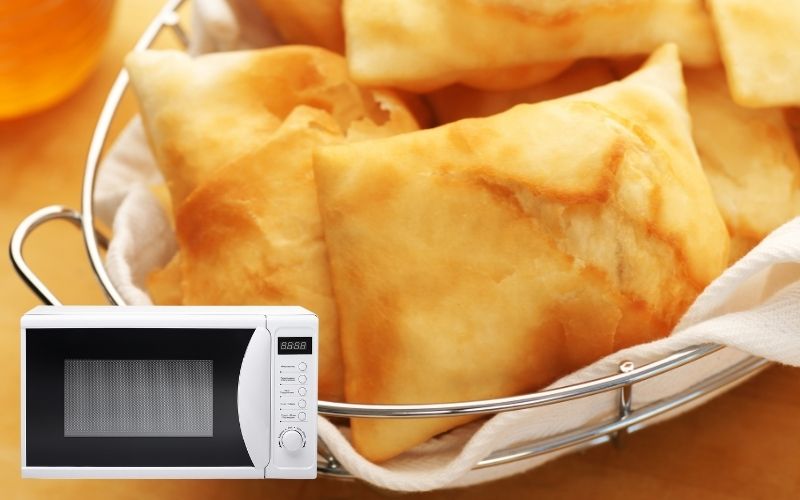Can You Cook Sopapillas in a Microwave? (Think Again…)
Did you know that you can make sopapillas using a microwave? Just kidding, not really. There’s a lot of factors that go into how sopapillas are made and what contributes to the texture and the crispiness that go into every bite.
But if you’re ever wondering if you can make sopapillas in your microwave, here’s your answer.
Can you cook sopapillas in a microwave?
While you can make sopapillas in a microwave, you’ll likely end up with a very dry, flat, and tough breading. It might not even be considered a sopapilla at all since it won’t look anything like one. Sopapillas are deserts that require deep frying, or at the very least, air frying, to get them to puff up and get crispy. Unfortunately, a microwave doesn’t cook in the same way as those appliances.
How to make sopapillas in a microwave
If you’re seriously wanting to cook your sopapillas using a microwave, then this is probably the best way to do so. Keep in mind that your results will not be anywhere close to what it’s like if you were to deep-fry, bake, or air fry it.
- Start with a large bowl.
- Mix 4 cups of all-purpose flour, 2 teaspoons of baking powder, 1 packet of active dry yeast, 1 teaspoon of salt, and 4 tbsp of shortening together.
- Add 1 and 1/2 cups of warm water and stir until the dough is smooth.
- Set it in the fridge for 20 minutes.
- Flatten it out with the roller on a board until it is 1/8 of an inch thick.
- Cut into 3 to 4-inch squares.
- Use an oil mister and spray both sides of the cut out squares. You can also use butter instead.
- Arrange as many squares as you can onto a microwave-safe tray on top of parchment paper in a single layer without them touching each other.
- Put it in the microwave and cook it for one minute on high.
- Then, flip it over and cook it for 3 more minutes.
- Take it out and enjoy it.
Why can’t you cook sopapillas in a microwave?
The whole premise of what microwaves do is that they use microwaves to vibrate the water inside food to create heat. This water will boil from the inside and try to escape.
This is the opposite of what convectional methods do in the cases of air frying, baking, and deep frying. With these methods, the heat comes from the environment and is transferred starting from the outside of the food and going inward.
For that very reason, as water moves out during microwaving, the food becomes drier and tougher. Sopapillas made in a microwave will end up being very flat and chewy as a result.
Why do sopapillas puff up?
When you bake, air fry, or deep fry bread, it rises because of the yeast inside of it. When you activate yeast by applying heat, it begins to feed on the sugars that are found in flour. As a result, it releases carbon dioxide gas from the inside and makes the bread rise.
Baking powder also has a similar effect.
What do sopapillas taste like when microwaved?
In most cases, the difference between deep-fried sopapillas and microwaved sopapillas is the textures. You’ll find that deep-fried sopapillas are much crispier, while microwaved sopapillas may taste a bit chewy and tough.
This is due to the fact that the moisture is lost when you microwave sopapillas.
Why did my microwave sopapillas not puff up?
When you cook using something like a deep fryer, the deep fryer will usually harden the outside of the sopapilla. As the yeast temporarily causes the breading to expand and puff up, the hardened exterior acts like a shell to keep the shape that it is in.
When you microwave a sopapilla, there is no hard shell that will help maintain the puffy shape of the sopapilla. It will rise thanks to the yeast, and then it will flatten shortly after.
How do you make sopapillas stay puffy in a microwave?
One method that many people use in order to keep bread puffy in a microwave is by running the microwave multiple times in short bursts.
But, you can try this method and see if it works for you.
Start by setting your microwave temperature to as low as possible. Heat it for about 1 minute, then let the sopapillas rest for about 3 minutes. Then, heat it up again for an additional 2 minutes and let it rest again for another 3 minutes.
The dough should increase in size and stay in a shape much bigger than it was before.
Can you reheat sopapillas in the microwave?
You can reheat sopapillas that are frozen or left in the fridge using a microwave. It is recommended to keep the cooking time under 5 minutes and turn it over midway in between. Again, the texture of your sopapillas will most likely end up a little dry and tougher due to the loss of moisture.
What’s the best alternative to making sopapillas
We’ve written a great article on how to cook your sopapillas using an air fryer here. It lists out all the steps and possible questions you may have about cooking sopapillas using an air fryer.
Other interesting articles:
